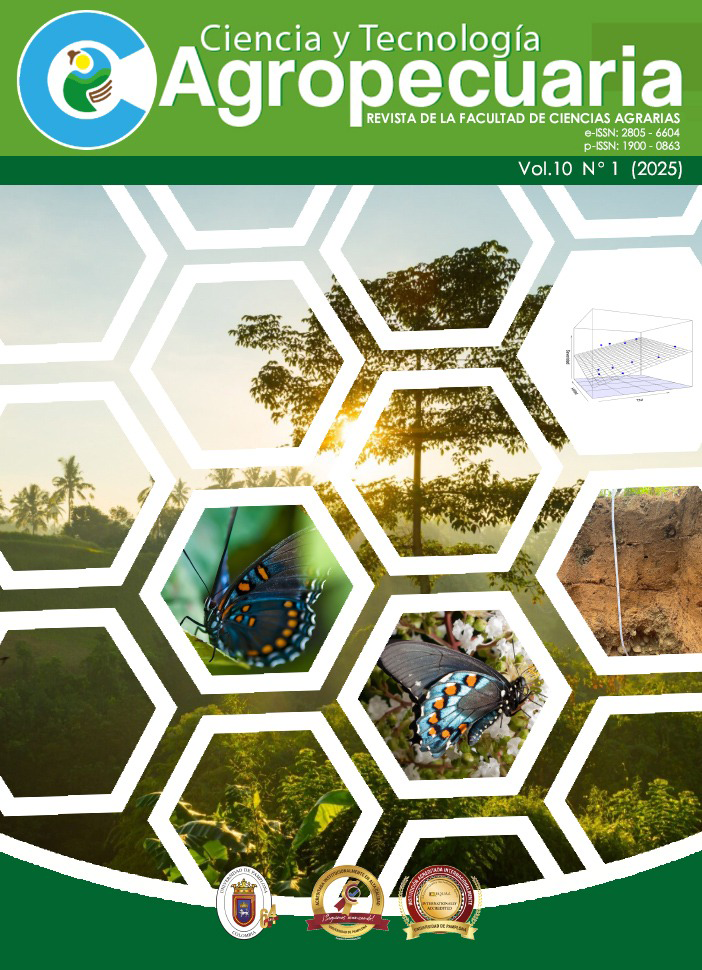Biological collection of lepidopterans from the Maria Lucía Metropolitan Park of the Meta University Corporation, Villavicencio, Colombia
DOI:
https://doi.org/10.24054/cyta.v10i1.4093Keywords:
Regional lepidopterology, entomofauna, environmental educationAbstract
Biological collections are veritable treasures of information that provide an invaluable historical perspective on biodiversity. These collections play an important role in various fields, both in research from taxonomy and ecology to the conservation of biodiversity. Thanks to biological collections, it is possible to find a source of historical record where covers the distribution and composition of different species over the years, in addition, by preserving these specimens, researchers can compare biological diversity at different times, which makes it possible to detect changes and/or loss of genetic diversity. To this end, a research was carried out with a descriptive non-experimental field design in 120 hectares of the María Lucia Metropolitan Park of the University Corporation of Meta. The biological collection of lepidoptera, being an important component in ecosystems, provides valuable information on biodiversity, climate effects and anthropogenic impacts. On the other hand, these biological collections play a crucial role in terms of education and scientific dissemination, so that in academic institutions they are not simply stores of specimens, living repositories that document the rich diversity of a specific region. The collections foster a greater understanding and appreciation of nature, in a world where biodiversity is threatened, these riches of information not only store the past but also guide the future of environmental conservation.
Downloads
References
Andrade-Correa, M., Campos-Salazar, L., González-Montaña, L. & Pulido-B., H. (2007). Santa María: Mariposas, alas y color. Guía de campo (1.ª ed., 1.ª reimp.). Colombia: Instituto de Ciencias Naturales, Universidad Nacional de Colombia.
García-R, S. (2020). Primates en las colecciones biológicas del departamento de Antioquia: Estado y potencial de investigación. Actualidades Biológicas, 42(112). https://doi.org/10.17533/udea.acbi.v42n112a03.
Huertas, B., Le Crom, J., & Correa Carmona, Y. (2022). Mariposas endémicas de Colombia: Una guía para la identificación de especies únicas del país. Colombia: Editorial: ProColombia.
Lemos, D. M. V., Ropero, M. C. G., & Forero, Y. R. (2015). Diversidad de mariposas diurnas (INSECTA: LEPIDÓPTERA) de un bosque subandino, Cajibío, Cauca. Boletín Científico Centro de Museos Museo de Historia Natural, 19(1), https://doi.org/10.17151/bccm.2015.19.1.20
Prudic, K. L., McFarland, K. P., Oliver, J. C., Hutchinson, R. A., Long, E. C., Kerr, J. T., & Larrivée, M. (2017). eButterfly: Leveraging Massive Online Citizen Science for Butterfly Conservation. Insects, 8(2), https://doi.org/10.3390/insects8020053
Quimbayo-Díaz, S., Moreno-Carmona, M., Tafur-Acosta, A. P., Andrade-C, M. G., & Canal, N. A. (2023). Rhopalocera del Museo Laboratorio Entomológico, Universidad del Tolima (Lepidoptera: Papilionoidea). SHILAP Revista de lepidopterología, 51(203), 457 - 477. https://doi.org/10.57065/shilap.532.
Rosario, M., & Camacho, C. (2015). Apuntes de metodología de la investigación. Santa Bárbara de Zulia, Venezuela: Dirección de publicaciones UNESUR.
Salazar, J., Nielsen, G., & Pacl, V. (2017). El Bosque de Bavaria (Villavicencio, Meta), revisitado: nuevos registros añadidos a la lista general de especies (Lepidóptera: Rhopalocera). Boletín Científico Centro de Museos Museo de Historia Natural, 21(2), 147-169.
Solano-Manzano, Á. M., Villalobos-Moreno, A., & Gallego-Ropero, M. C. (2024). Mariposas Dismorphiinae (Lepidoptera: Pieridae) de la Colección de Entomología del Museo de Historia Natural de la Universidad del Cauca, Popayán, Colombia. Rev. Chilena de Entomología, 50(1). https://www.biotaxa.org/rce/article/view/85435
Velasco-Rojas, G. D., Gallego-Cotazo, K. N., Becoche-Mosquera, J. M., & Bolaños-Martínez, I. A. (2021). Mariposas (Lepidoptera: Papilionoidea) de Tierradentro, San Andrés de Pisimbalá, Cauca, Colombia. Actualidades Biológicas, 43(115), 1–16. https://doi.org/10.17533/udea.acbi/v43n115a04.
Vélez-Estrada, J., & Ríos-Málaver, I. (2018). Colombia, país de mariposas. Bogotá, Colombia: Villegas Editores.
Downloads
Published
How to Cite
Issue
Section
License
Copyright (c) 2025 Joan Sebastian Gracia Rojas, Tatiana Navarro Tamayo, Luz Dary Pedraza Hernández, Hebandreyna González García, Lina Fernanda Mojica Sánchez

This work is licensed under a Creative Commons Attribution-NonCommercial-ShareAlike 4.0 International License.










